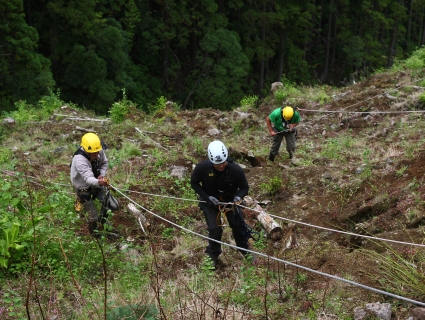

La restauración ecológica de la laurisilva de las Azores fue la principal acción de conservación desarrollada para la recuperación del camachuelo de las Azores. La restauración se lleva a cabo mediante la eliminación química de la especie invasora, ya que ningún método manual o mecánico resultó eficaz. Tras la eliminación, se lleva a cabo la estabilización del suelo, recurriendo a técnicas de ingeniería natural cuando es necesario, y se planta la zona con especies autóctonas y endémicas producidas en los viveros. En las manchas de rodales de EEI puras, se ha probado la tala de árboles invasores con tratamiento químico y los tratamientos químicos en árboles en pie, que se utilizan en función de las condiciones del terreno. Hasta ahora se han restaurado más de 350 hectáreas de bosques autóctonos, incluidas 295 hectáreas de laurisilva húmeda y 31 hectáreas de laurisilva mésica muy degradada. Se espera que esta cantidad aumente en 80 hectáreas más al final del presente proyecto.
La restauración ecológica de las turberas se llevó a cabo retirando el ganado de pastoreo de la zona, eliminando manualmente las EEI (concretamente Gunnera tinctoria), cerrando las zanjas de drenaje e inoculando musgos de turbera en las charcas de inundación generadas. Esta restauración activa se llevó a cabo en una superficie de 75 hectáreas. Esta experiencia de restauración nos ha permitido desarrollar técnicas que se han reproducido en las Azores.
- Financiación de la Comisión Europea a través del Programa LIFE;
- Propiedad pública de la zona de intervención;
- Apoyo científico y técnico de un consejo asesor;
- Desarrollo de técnicas específicas para el control de las EEI y técnicas de bioingeniería;
- Disponibilidad de un número importante de plantas autóctonas para plantar en las zonas restauradas.
- Lo ideal es que las intervenciones de control de las EEI se lleven a cabo en cuanto se detecten los primeros individuos; de lo contrario, esas intervenciones tendrán unos costes mucho más elevados y serán menos eficaces.
- Utilizar y adaptar técnicas ya desarrolladas para la restauración ecológica puede ahorrar mucho tiempo y mejorar el éxito.
- Hemos podido aprender de nuestros errores; el seguimiento continuo permite aprender de la práctica y mejorar las técnicas de control de EEI, estabilización de suelos y taludes con ingeniería natural y producción vegetal.
- La supervisión y el mantenimiento regular de las zonas restauradas son indispensables para garantizar el éxito a largo plazo.
- La concienciación pública es un factor clave para controlar la propagación de las EEI.
- Son necesarias estrategias multisectoriales y de múltiples partes interesadas para la gestión de los problemas de las EEI. Deben promoverse al más alto nivel, pero aplicarse a escala local para incluir las especificidades de cada zona.
- Esta experiencia de restauración nos ha permitido desarrollar técnicas que han sido replicadas en otras zonas del archipiélago por otras entidades.